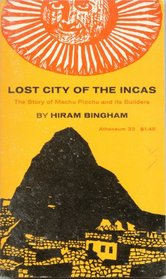For those interested in ancient civilizations this is actually a famous book. I enjoyed reading about the Incan culture and history, but Bingham lost me in those chapters about their architecture, as that is not an area I'm interested in.
If you look back with to his time with today's values, one startling aspect is how he raided the burial grounds for the skeletons of the people buried there. But then he was led to them by the local Indians, who received bonuses for doing do. Today, those people would be lodging lawsuits against his deprivations. And Bingham alludes more than once how many of these natives 'belonged' to local planters and politicians.
Two pieces of trivia I enjoyed were :
1) In the Introduction, by a present day archeologist, Bingham is said to have 'sort of' made his find of Machu Picchu more mysterious by deliberately not taking photographs of land cleared by the local to plant crops. But only photographs of the building covered with vines, so as to make it appear he was the first to rediscover the site. Not the first time a scientist has fudged the truth to make a 'discovery' appear his or her own.
2) One Spanish viceroy of Peru was the Count of Chinchru whose wife was cured of malaria by the use of "Peruvian bark" This was called 'kina,' which we now call quinine. The plant species is called chinchru after him.
If you look back with to his time with today's values, one startling aspect is how he raided the burial grounds for the skeletons of the people buried there. But then he was led to them by the local Indians, who received bonuses for doing do. Today, those people would be lodging lawsuits against his deprivations. And Bingham alludes more than once how many of these natives 'belonged' to local planters and politicians.
Two pieces of trivia I enjoyed were :
1) In the Introduction, by a present day archeologist, Bingham is said to have 'sort of' made his find of Machu Picchu more mysterious by deliberately not taking photographs of land cleared by the local to plant crops. But only photographs of the building covered with vines, so as to make it appear he was the first to rediscover the site. Not the first time a scientist has fudged the truth to make a 'discovery' appear his or her own.
2) One Spanish viceroy of Peru was the Count of Chinchru whose wife was cured of malaria by the use of "Peruvian bark" This was called 'kina,' which we now call quinine. The plant species is called chinchru after him.




